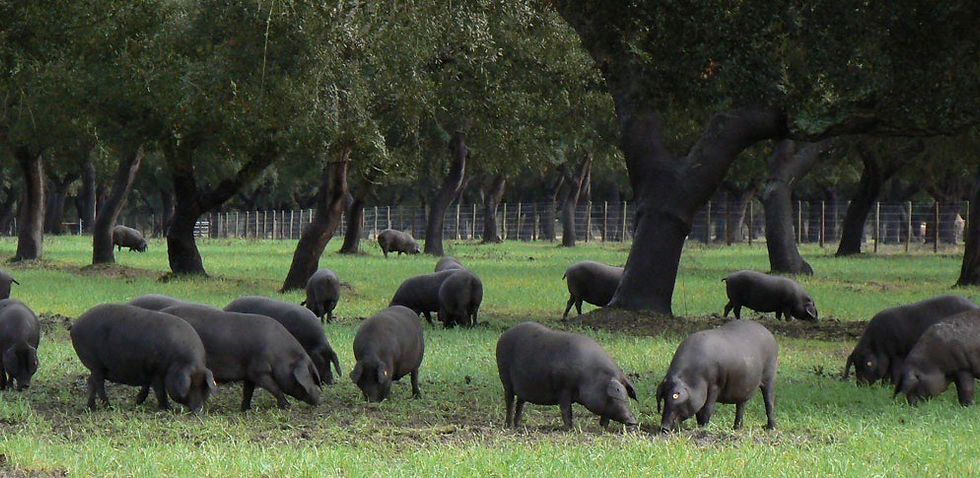
This week was marked by the death of an Icon, without doubt the world’s most respected person held in awe by many of us. The passing of a life dedicated to duty. Farewell Queen Elizabeth II.
I was going to include my last contact in the bush war, unfortunately, I am unable to do that as I have now strictly set my target to a 2,000-word limit as I am assured by those that know 1,500 to 2,000 words are ideal for a blog such as mine. It seems if you exceed that number of words people lose interest and importantly nor do they have the time to read anything longer? So the contact story is going to be next week which makes it easy as I have gone through it many times over the years in my head, luckily never in my dreams. Memory is a struggle. I have just purchased Ross Gordon’s book on his life in Zimbabwe. Ross is the son of John, my neighbour, and flicking through it, it has brought back many forgotten memories about his family and the area. This week's blog is all the present, no past, as I planned the blog to be. Apologies.
Bloody punctures! Since arriving in Portugal I have not had to stop and change a car tyre since my big car lost its valves. Even then, due to the guarantee given by Jaguar they came and sorted the problem out. Today, Tuesday, I decided to sort out a tyre puncture on my wheelbarrow. Nothing harder to push than a wheelbarrow with a soft tyre. This is the second round of annoying slow punctures on the damn wheelbarrow, so on advice from ‘the madam’, we decided to fill it with that foam usually used by cyclists. Problem solved. Then off to lunch in our seventeen-year-old-reliable Nissan X-Trail whereupon we encountered another vehicle on the narrow dirt road which acts as a backroad to our favourite restaurant. At weekends this road is at its busiest, with late-night revellers using it rather than face the danger of attracting the police on the main road. Admittedly the police are rarely seen on the roads at night.
Anyway, the road edge has sharp rocks and negotiating past the oncoming vehicle I slashed my tyre on a rock on the steepest place. What to do, stop and change on the hill or risk ruining my rim? Stop I did and out with the jack, setting Rozanne into action under the car. After all, I am seventy-three in a couple of months. Meanwhile, informing our friend John Tidy, who we were meeting for lunch, that we would be late. Stones behind the rear tyres, handbrake on, let’s jack. Fine until the tyre left the dirt and despite being in gear, stones in place in front of tyres as chocks and the handbrake on, the damn thing rolled off the jack. Our jack, a stupid device with about a four-square inch footpad and a six-inch screw device to raise it. Something you would throw away in Africa where punctures are common due to potholes. Not here in Europe where they are rare and jacks hardly used. On the highways, assistance mostly comes to your aid as it is deemed dangerous for you to be stopped at the side of the road.
“One of the main differences travelling in Europe compared to Africa is that nobody appears out of the bushes on a lonely road. In Africa no matter where you are, even when just wanting a quick pee, when you stop, a happy smiling face will appear asking, “Can I/we help?” - Peter McSporran
With this failure, John arrived thinking we would probably need help, which we surely did on the steep gravel road. So now two jacks brought into play, more and larger rocks as chocks. Once again as we tried to put the new tyre on the damn vehicle, it rolled off the jack for the second time. Shit! And shit again! New plan. Use his Landcruiser as an anchor to prevent the Nissan from rolling forward by means of a taunt tow rope. This finally worked, tyre changed successfully with no injuries, followed by a splendid two-and-a-half-hour lunch. After all, the tyre place will only open after siesta time. Aaah, that specific Goodyear tyre, they have stopped making, so for safety, you should replace both front tyres with this new design. I believed them as this was the second place declaring the same claim. In old age, punctures are dangerous and expensive. “Of course we have, but only tomorrow,” says the tyre fixer.
“In modern Europe, a computer terminal and a white delivery van are the equivalent of stock on the shelf. Always available, but only tomorrow.” - Peter McSporran
This was following a trouble-free nine hundred odd kilometre round trip to Michele and Scott von Memerty in Southern Spain over the weekend. They live in a town or rather village, Zalamea la Real. Last week was their annual fiesta and bullfight which we had travelled to attend with them. The bullfight being local, only in location and venue as the matadors, horses and bulls are sourced from normal national providers. In saying that, there are many bullfighting ranches in that area so perhaps the bulls were local. The area is full of oak forests providing acorns for the famed Iberian Black Pig which is raised free range often seen as you drive through the mountains.
The fiesta started on the Monday before our arrival. For those of you unaware of how fiestas work in rural towns like Spain and Portugal, they are normally at least four day and night events from Thursday until midnight on the Sunday, sometimes even through to Monday morning. The only difference between day and night is that the music is louder in the evenings. You have religious fiestas, honey harvest fiestas, olive harvest fiestas, walnut harvest fiestas, you name it, there is a harvest or religious fiesta for it. Of course, the equivalent of the Iberian Lunar Park follows the fiestas from venue to venue. You go to bed with the sounds of partying, especially bass drums and you are sure to wake up to the same the next day, that is if you are able to sleep. In Zalamea la Real everyone has plots of land where they house numerous packs of hunting dogs which add to the cacophony. It must have the largest ratio of dogs per person in the world.
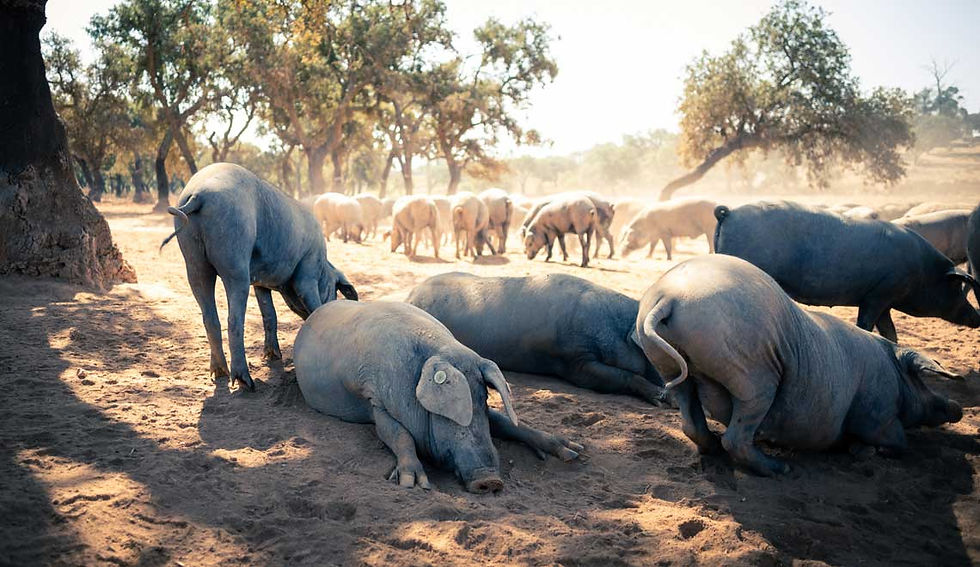
On the first night we arrived, it was the Grand Prix held in the bullring. This entailed two teams competing with each other on or over various obstacles very much like those you see on TV with idiots leaping or jumping into, over or under dry and wet challenges. Mad. Then the teams play football but for added entertainment, a steer is released to ensure some antics as the participants not only have to concentrate on the ball but also on the horns. For some reason, these steers have an attitude similar to the bulls, feisty. Although much smaller, they do have sharp horns. This was followed by a game of seesaw with a fresh steer, the idea being for your mate to lift you above the animal's head as the steer charges. Points are gained in all the games not just by score but also crowd approval. A fun evening with the bullfight stadium filled with families.
The next day, further revelling with the grand parade of the bulls in the evening, each bull let into the ring for minutes and out again. Some took a lot more than a few minutes to get out. Exit can only be done by attraction not herding for obvious reasons. People behind barriers would attract the attention of the bull to demonstrate its power and aggression as it charged across the ring. I think I must reiterate that these bulls have an attitude, as I told you last week. I think combined with being out of the herd coupled with their inbred aggressive temperament, they see their only defence being attack.

The next day was the bullfight. Did we want to go? Not really, I suppose if I am truthful but felt the need to view before we threw stones and better understand the Iberian psychic. We had arranged with Michel and Scott much earlier in the year to attend a bullfight. This was prior to our decision to attend the Portuguese one. Both for interest and the need for comparison were at play here along with a hankering to experience what Hemingway saw. The bull fighting photos I took at the event.
“Bullfighting is the only art in which the artist is in danger of death and in which the degree of brilliance in the performance is left to the fighter’s honor.” - Ernest Hemingway.
Not as much pomp and ceremony as we witnessed in Portugal, perhaps as it was a small rural venue. Notwithstanding that, all the strict rules and rituals are adhered to. This includes timings and due process. The first stage is the ercio de varas, the part of the lances. The matador faces the bull with his aids close by to attract the bull's attention if there's a problem. To all intent and purpose, he is on his own with the unwounded bull at its fittest. All bulls are generally between five hundred and fifty and seven hundred and fifty kilograms and must be at least four years old. This part of the fight is when the matador observes the action and nature of the bull as he teases it into charge. Why does it always charge the cape and not the man, even if the man is within inches of the bull’s horns? In the beginning, he has no sword. During this period a number of pretty spectacular passes take place, all passes have some name, some more daring and complicated than others. If you are a bullfighting fundi, you will know when to clap unlike us who had to follow the audience.
“The first mistake many of us make is we think animals are like humans in nature and thought.” - Peter McSporran
Instead of barbs being placed by prancing unprotected horses and skilled horsemen as in Portugal, the bull is at the end of this period spiked on the top of the shoulder by a horseman mounted on a protected Shire-type horse. No skill, just brute force. This spiking as such is not done in Portugal. I did not like this.
“The second mistake we make is we forget humans are animals. Further, they are the cruellest of all animals as they have a conscience and are aware of the consequences of their actions.” - Peter McSporran
Then, the next stage Is the tercio de banderillas. The section of the small flag which is a number of barbs placed on the bull's shoulder takes much skill and dexterity. Yes, I did write dexterity. This is what is done in Portugal when small barbs are placed in the shoulder of the bull by the cavaleiros or banderillas. So this is similar in both countries except not from a horse in Spain.
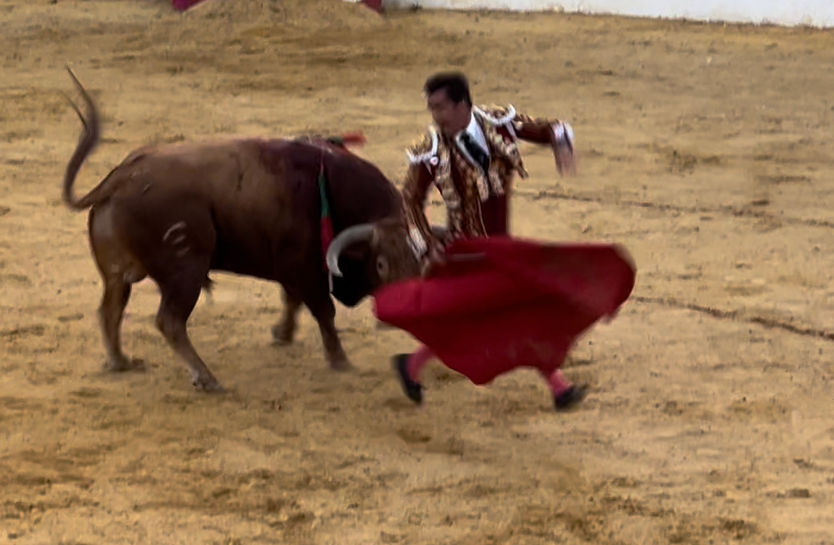
The final stage is when the tercio de muerte, the killing of the bull, takes place. This is when the matador changes his large cape, muleta, for a small cape and has his sword to hand. He has a limited time to kill the bull and this traditionally should be done by one thrust through the top of the bull's shoulders into the heart also cutting the aorta. Before so, he carries out a number of close-quarter passes with the very small cape. What happened in our case? The first matador, the country’s present foremost matador, bodges it and the kill was not clean. Very unsettling even for livestock farmers who have seen many animals slaughtered. This attracts the disgust of the crowd who rather than cheer, boo and shout abuse. The worst would be to fail to kill the bull, then the matador would have to leave the ring in shame. There were two bullfighters and six bulls. I believe it is always six bulls at any event and normally three matadors. Approval of both bull and matador is done by waving white handkerchiefs. As in Portugal, a brass band heralds and accompanies each stage.
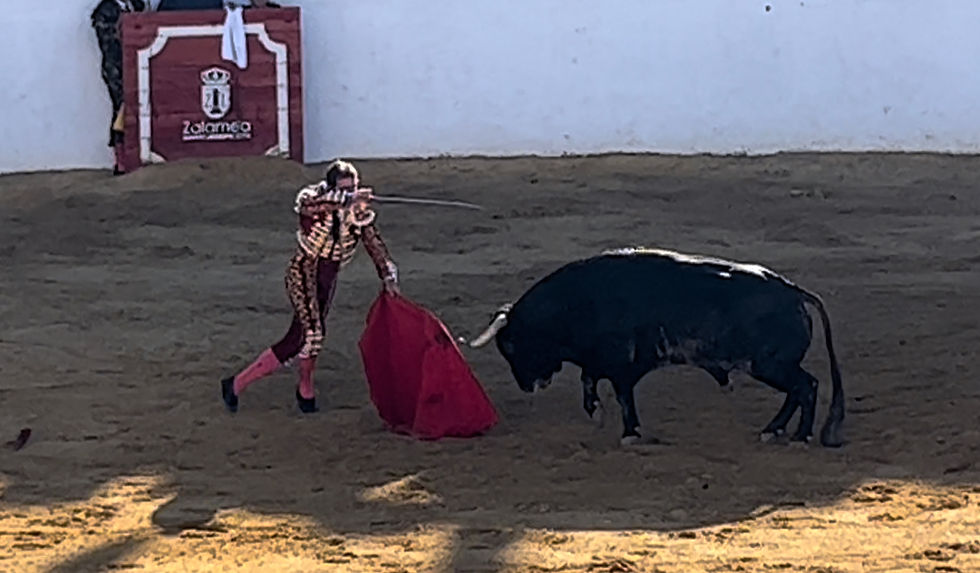
All the other kills were clean, the swords penetrating into the charging bull's heart faster than the eye can see right to the hilt. The bull quickly dies, despite this, a coup de grace is given into the back of the head to ensure instant death once he falls. Not as much blood as I would have expected except for the one killed badly. Matadors are skilled performers, brave, full of bravado and ultra supple. Their adrenaline-ignited eyes are only overshadowed by their shining white teeth always on show. Would I go and see a Spainish bullfight again? I do not think so, I found the skills of the horsemen and the wrestling of the bull by the forcados in Portugal much more impressive than the killing of the bulls in Spain. Perhaps more humane. I do, however, respect it as part of the respective country's culture. Of interest, there was not one demonstrator present.
“In many ways, the social fabric of many countries are being destroyed as the links to our historical cultural heritage are being outlawed under the guise of political correctness.” - Peter McSporran
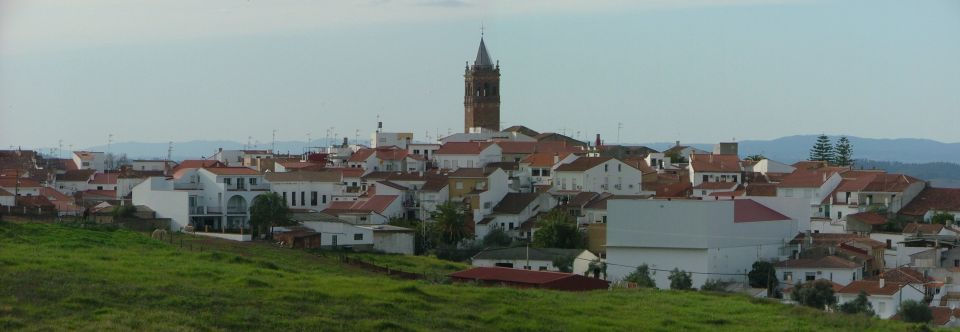
The town where it was held, Zalamea la Real has a population of only 3,000 while the bullring, plaza de toros, was packed with some 4,000 spectators, with many family members returning to their rural homes for the fiesta and bullfight ensuring the continuity of social bonds. A huge annual event, so important to their social structure, culture and family ties.
Disclaimer: Copyright Peter McSporran. The content in this blog represents my personal views and does not reflect corporate entities.
Comments